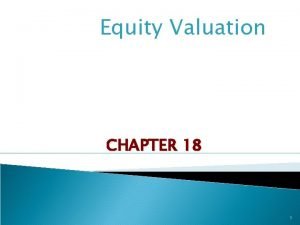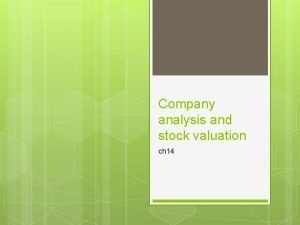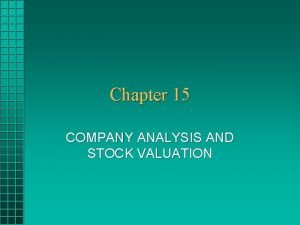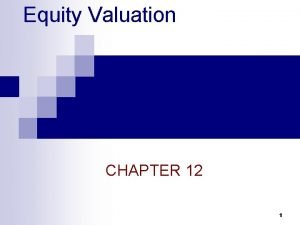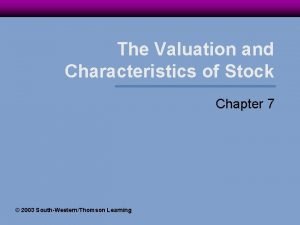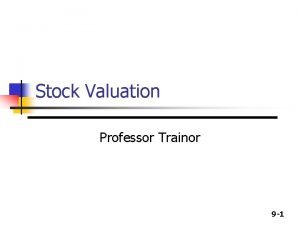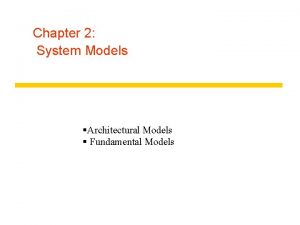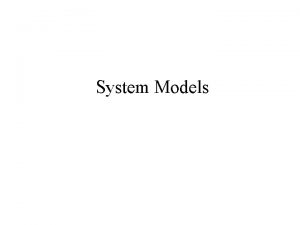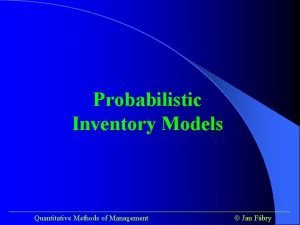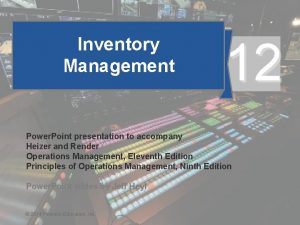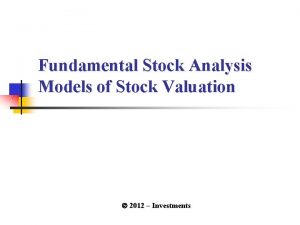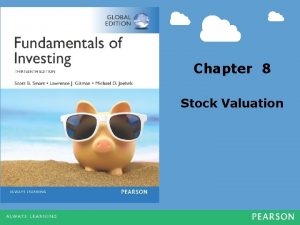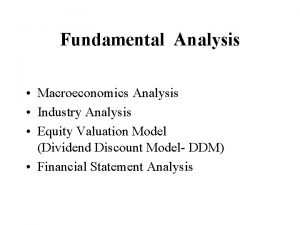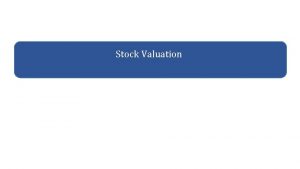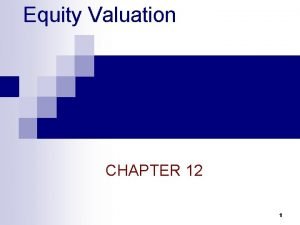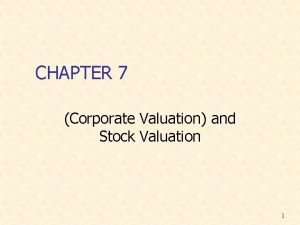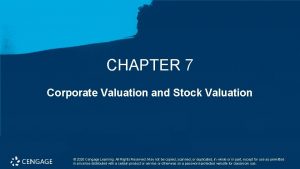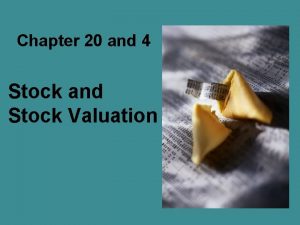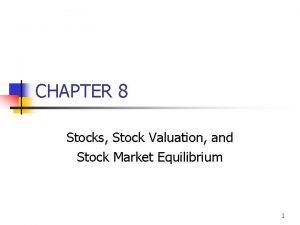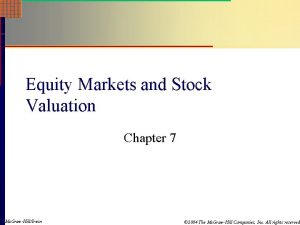Chapter 18 Equity Valuation Fundamental Stock Analysis Models
























- Slides: 24

Chapter 18 Equity Valuation

Fundamental Stock Analysis: Models of Equity Valuation • Basic Types of Models • Balance Sheet Models • Dividend Discount Models • Price/Earning Ratios • Estimating Growth Rates and Opportunities Mc. Graw-Hill/Irwin © 2004 The Mc. Graw-Hill Companies, Inc. , All Rights Reserved.

Dividend Discount Models: General Model • V 0 = Value of Stock • Dt = Dividend • k = required return Mc. Graw-Hill/Irwin © 2004 The Mc. Graw-Hill Companies, Inc. , All Rights Reserved.

No Growth Model • Stocks that have earnings and dividends that are expected to remain constant • Preferred Stock Mc. Graw-Hill/Irwin © 2004 The Mc. Graw-Hill Companies, Inc. , All Rights Reserved.

No Growth Model: Example E 1 = D 1 = $5. 00 k =. 15 V 0 = $5. 00 /. 15 = $33. 33 Mc. Graw-Hill/Irwin © 2004 The Mc. Graw-Hill Companies, Inc. , All Rights Reserved.

Constant Growth Model • g = constant perpetual growth rate Mc. Graw-Hill/Irwin © 2004 The Mc. Graw-Hill Companies, Inc. , All Rights Reserved.

Constant Growth Model: Example E 1 = $5. 00 b = 40% k = 15% (1 -b) = 60% D 1 = $3. 00 g = 8% V 0 = 3. 00 / (. 15 -. 08) = $42. 86 Mc. Graw-Hill/Irwin © 2004 The Mc. Graw-Hill Companies, Inc. , All Rights Reserved.

Estimating Dividend Growth Rates • g = growth rate in dividends • ROE = Return on Equity for the firm • b = plowback or retention percentage rate • (1 - dividend payout percentage rate) Mc. Graw-Hill/Irwin © 2004 The Mc. Graw-Hill Companies, Inc. , All Rights Reserved.

Estimating Growth via historical info. • Dividend in 2000 was $1. • Dividend in 2006 was $1. 80 • Growth is (1. 80/1)^(1/6)-1 = 10. 29% Mc. Graw-Hill/Irwin © 2004 The Mc. Graw-Hill Companies, Inc. , All Rights Reserved.

Specified Holding Period Model • PN = the expected sales price for the stock at time N • N = the specified number of years the stock is expected to be held Mc. Graw-Hill/Irwin © 2004 The Mc. Graw-Hill Companies, Inc. , All Rights Reserved.

Partitioning Value: Growth and No Growth Components • PVGO = Present Value of Growth Opportunities • E 1 = Earnings Per Share for period 1 Mc. Graw-Hill/Irwin © 2004 The Mc. Graw-Hill Companies, Inc. , All Rights Reserved.

Partitioning Value: Example • ROE = 20% d = 60% b = 40% • E 1 = $5. 00 D 1 = $3. 00 k = 15% • g =. 20 x. 40 =. 08 or 8% Mc. Graw-Hill/Irwin © 2004 The Mc. Graw-Hill Companies, Inc. , All Rights Reserved.

Partitioning Value: Example Vo = value with growth NGVo = no growth component value PVGO = Present Value of Growth Opportunities Mc. Graw-Hill/Irwin © 2004 The Mc. Graw-Hill Companies, Inc. , All Rights Reserved.

Free Cash Flow to Equity A much better model is to apply discount models to FCFE which may more accurately reflect a firms value. FCFE = Net Income + depreciation – Cap. Expend. – change in working capital – principal debt repayments + new debt issues. Apply model as per usual. Mc. Graw-Hill/Irwin © 2004 The Mc. Graw-Hill Companies, Inc. , All Rights Reserved.

Free Cash Flow to Equity • If the firm finances a fixed percentage of its capital spending and investments in working capital with debt, the calculation of FCFE is simplified. Let DR be the debt ratio, debt as a percentage of assets. In this case, FCFE can be written as • FCFE = NI – (1 – DR)(Capital Spending + change in Working Capital – Depreciation) • When building FCFE valuation models, the logic, that debt financing is used to finance a constant fraction of investments, is very useful. This equation is pretty common. Mc. Graw-Hill/Irwin © 2004 The Mc. Graw-Hill Companies, Inc. , All Rights Reserved.

Let’s look at an example http: //faculty. etsu. edu/trainor/FNCE%2033 00/Lowes. doc Another interesting site you may want to use: http: //caps. fool. com/Ticker. aspx? source=i caedilnk 9950012&ticker=LOW Mc. Graw-Hill/Irwin © 2004 The Mc. Graw-Hill Companies, Inc. , All Rights Reserved.

Free Cash flow to the Firm • FCFF = EBIT(1 -tax rate) + Dep. – Cap. Expenditures – Change in WC – Change in other assets. • Again, proceed as normal(replace dividends with FCFF) but discount at firms cost of capital. • You find value of firm. To find value of equity, simply subtract off debt. Mc. Graw-Hill/Irwin © 2004 The Mc. Graw-Hill Companies, Inc. , All Rights Reserved.

Price Earnings Ratios • P/E Ratios are a function of two factors • Required Rates of Return (k) • Expected growth in Dividends • Uses • Relative valuation • Extensive Use in industry Mc. Graw-Hill/Irwin © 2004 The Mc. Graw-Hill Companies, Inc. , All Rights Reserved.

P/E Ratio: No expected growth • E 1 - expected earnings for next year • E 1 is equal to D 1 under no growth • k - required rate of return Mc. Graw-Hill/Irwin © 2004 The Mc. Graw-Hill Companies, Inc. , All Rights Reserved.

P/E Ratio with Constant Growth • b = retention ration • ROE = Return on Equity Mc. Graw-Hill/Irwin © 2004 The Mc. Graw-Hill Companies, Inc. , All Rights Reserved.

Numerical Example: No Growth E 0 = $2. 50 g=0 k = 12. 5% P 0 = D/k = $2. 50/. 125 = $20. 00 PE = 1/k = 1/. 125 = 8 Mc. Graw-Hill/Irwin © 2004 The Mc. Graw-Hill Companies, Inc. , All Rights Reserved.

Numerical Example with Growth b = 60% ROE = 15% (1 -b) = 40% E 1 = $2. 50 (1 + (. 6)(. 15)) = $2. 73 D 1 = $2. 73 (1 -. 6) = $1. 09 k = 12. 5% g = 9% P 0 = 1. 09/(. 125 -. 09) = $31. 14 PE = 31. 14/2. 73 = 11. 4 PE = (1 -. 60) / (. 125 -. 09) = 11. 4 Mc. Graw-Hill/Irwin © 2004 The Mc. Graw-Hill Companies, Inc. , All Rights Reserved.

Pitfalls in Using PE Ratios • Flexibility in reporting makes choice of earnings difficult • Pro forma earnings may give a better measure of operating earnings • Problem of too much flexibility Mc. Graw-Hill/Irwin © 2004 The Mc. Graw-Hill Companies, Inc. , All Rights Reserved.

Other types of Valuation • Use Price/sales • Price/Cash flow • All relative valuation models rely on the market to be fairly valued. What is a good Price/Sales ratio? Relies on comparisons which may or may not be valued accurately. Mc. Graw-Hill/Irwin © 2004 The Mc. Graw-Hill Companies, Inc. , All Rights Reserved.
 Equity markets and stock valuation
Equity markets and stock valuation Equity analysis and valuation
Equity analysis and valuation Dividend discount model
Dividend discount model Company analysis and stock valuation
Company analysis and stock valuation Company analysis stock valuation
Company analysis stock valuation Fixed income introduction
Fixed income introduction Importance of equity
Importance of equity Equity valuation ppt
Equity valuation ppt Equity valuation formula
Equity valuation formula Avco method of stock valuation
Avco method of stock valuation Characteristics of stock valuation
Characteristics of stock valuation Inventory valuation methods pdf grade 12
Inventory valuation methods pdf grade 12 Dividend growth model formula
Dividend growth model formula Preferred stock valuation
Preferred stock valuation Distributed system models
Distributed system models Fundamental model in distributed system
Fundamental model in distributed system Architectural and fundamental models of distributed system
Architectural and fundamental models of distributed system Long-term debt preferred stock and common stock
Long-term debt preferred stock and common stock Macam macam stock
Macam macam stock Characteristics of common stock
Characteristics of common stock Stock final de marchandises
Stock final de marchandises Probabilistic models and safety stock
Probabilistic models and safety stock Probabilistic models and safety stock
Probabilistic models and safety stock Modals and semi modals difference
Modals and semi modals difference Chapter 7 interest rates and bond valuation
Chapter 7 interest rates and bond valuation


